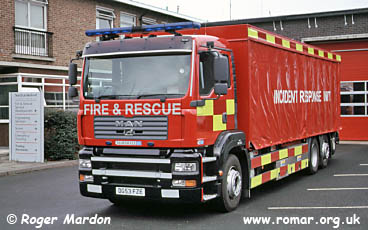

Fire service historian and author
Roger Mardon

www.romar.org.uk
© Copyright Roger Mardon
www.romar.org.uk
All rights reserved

The Government’s New Dimension initiative is a response to the terrorist attacks on the World Trade Centre in New York on 9 September 2001 with the intention of ensuring that Britain’s fire and rescue services are able to cope with major chemical, biological, radiological, nuclear (CBRN) and conventional terrorist incidents on a national scale. This means that the fire service is better equipped to deal with any other CBRN incident as well as industrial and domestic accidents, chemical spills and collapsed buildings, and natural disasters such as floods and earthquakes.

The fire service in England and Wales comes within the responsibilities of the Department
for Communities & Local Government (DCLG), which succeeded the Office of the Deputy
Prime Minister (ODPM) on 5 May 2006. Within that department responsibility is devolved
to the Fire & Resilience Directorate, which was created in January 2006 by the merger
of the Civil Resilience Directorate and the Fire & Rescue Service Directorate. The
former Civil Resilience Directorate was established under the ODPM to co-
Equipping the service to undertake mass decontamination and search & rescue is the
first part of the programme, to be followed by changes in the system of radio communications
and the provision of regional fire control rooms. Known as Firelink, a new national
wide-
There are 46 fire control rooms in England. It was claimed that their replacement by nine new regional control centres would enhance the ability of the fire and rescue service to respond to incidents on a local, regional or national level. It was also said a more efficient and effective service would be provided. The controversial Government plan for the new centres was abandoned in December 2010.
Phase 1 of the New Dimension programme comprised the development and supply of a fleet of 80 mass decontamination vehicles, now know as incident response units (IRUs), at a cost of £54m.
Phase 2 involved the provision of 238 prime movers to carry a range of demountable units. Of these 162 have been allocated to fire & rescue services, 7 have been sold to Scotland, 11 to Northern Ireland and one to Staffordshire Fire & Rescue Service. The remaining 57 appear to be surplus to requirements and plans are in hand to distribute them to brigades in England.
Phases 2A and 2B comprised the provision of the demountable units, including high
volume pumping units, urban search and rescue units, and mass decontamination units.
Further units had been expected, including water rescue, welfare, stores and power
but provision of these is no longer the case. Command & control units, originally
conceived as demountables, will now be smaller purpose-
New Dimension vehicles are currently the property of the DCLG and are seen as a national
resource that can be deployed anywhere in country as required. However the Government
intends to transfer ownership of New Dimension assets to individual fire & rescue
authorities and is now aiming for this to take place on 1 October 2009. Maintenance
of vehicles and equipment will be managed on behalf of all authorities by a centrally
appointed contractor to ensure that they remain fit to respond to regional and national
emergencies. It was announced on 9 July 2008 that a 16-
Details made available from various sources are brought together in the following pages which will be updated as more information is released. Nothing has been provided which is not in the public domain and the assistance of the DCLG Fire & Resilience Directorate, Marshall SV of Cambridge and Kuiken Hytrans b.v of The Netherlands in providing information is gratefully acknowledged. Thanks are also due to those others who have allowed their photographs to be used; their images are individually credited.
New Dimension
Previous
Next